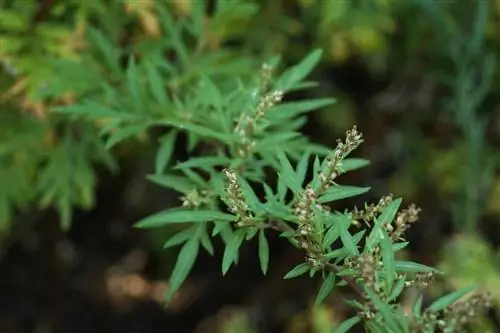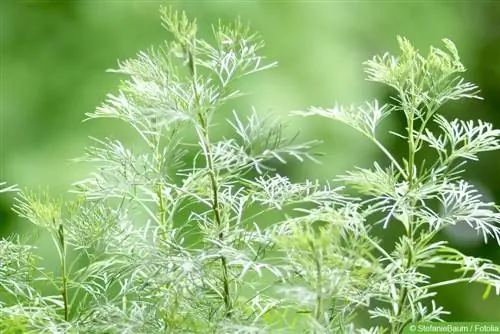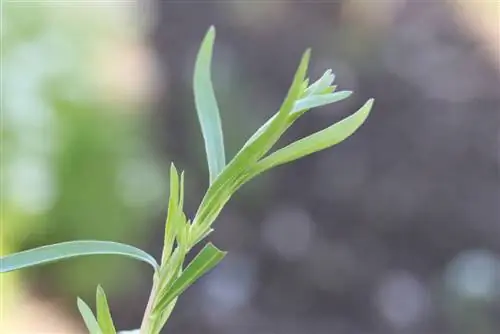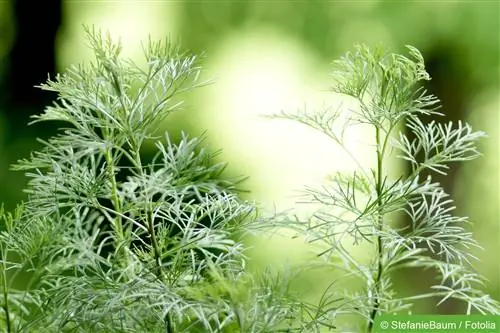- Author admin [email protected].
- Public 2023-12-17 03:39.
- Last modified 2025-06-01 06:48.
Mugwort or Artemisia vulgaris, as the plant is called by its botanical name, is a versatile plant. Whether it is used as a spice in the kitchen or for its medicinal properties - it is worth growing in a garden bed or container. And it's very simple.
Mugwort flavors fatty foods and makes them easier to digest, can be enjoyed as a tea or relieves cramps - these alone are many good reasons that make this appetizing herb an enrichment in the garden and on the balcony.
But these are by far not the only advantages that Artemisia vulgaris has to offer. Added to this is its easy-care nature, which makes the plant ideal even for beginner gardeners. If you want to enjoy the fresh leaves, roots and tubers, all you have to do is follow the following tips.
Location
When choosing the location, the grateful mugwort proves to be easy to care for and undemanding. Full sun or partial shade, it tolerates both. It just shouldn't get too dark for him. Artemisia vulgaris still grows in the shade, but then produces significantly fewer essential oils. The taste and effect suffer as a result.
You should also make sure there is enough space. The mugwort can reach a height of up to two meters. Accordingly, the plant needs a lot of free space upwards. And the planter should be correspondingly large when growing on the balcony.
Mugwort gets along well with other herbs and plants. And it doesn't compete with them either. Particularly suitable neighbors are:
- Sage
- Chamomile
- Oregano
- Marigold
- Cornflower
- St. John's Wort
Tip:
Basically with all plants that place similar demands on the location.
Substrate
Loose, rich in humus and with a moderate nutrient content - this is what the ideal substrate for Artemisia vulgaris looks like. But he is also satisfied with less. However, if you want to do something good for it and ensure rapid growth, rely on potting soil or garden soil that is enriched with mature compost and loosened up with small-grain gravel.
Plants
Mugwort can be grown in different ways. You can either sow it directly in a bed or planter, grow it early or buy it as a plant. Of course, it's particularly quick and easy if you rely on plants that have already been grown. Planting the seeds or germinating them yourself is also easy.
Pre-germinating seeds and sowing
The seeds can be grown indoors from February onwards. To do this, the seeds are placed on growing soil, watered but not covered with substrate. Because mugwort is a light germinator. A transparent film can be placed over the planter to protect it from drying out.
If the moisture is maintained evenly but never soggy and there is sufficient light, the seeds germinate quite quickly and can be pricked out after eight weeks and taken outdoors.
From April, sowing can be done directly outdoors. As does the planting of young plants. It is important to note that the plants are either given sufficient distance - or they have to be pricked out again. There should be 50 cm between the rows, otherwise it will quickly become too narrow for the Artemisia vulgaris perennials.
Pouring
The mugwort basically only needs additional watering if it is cultivated in a bucket or pre-germinated. Once grown in the bed, it takes care of itself. The only exception is prolonged dry phases. It is important to avoid waterlogging in any case, as Artemisia vulgaris takes offense at this. Rainwater or tap water can be used for watering - it is the same as mugwort.
Tip:
The already low watering effort can be further reduced if the mugwort is treated to a layer of mulch.
Fertilize
If you use compost or horn shavings when planting the plants, you can save on fertilizer. A single dose each spring is completely sufficient. Mulch is again an advantage here; when it rains and through irrigation water, nutrients from it reach the soil and thus provide long-term care for the plants.
Harvest
Roots, leaves, fruits and flowers of the mugwort herb are suitable for harvesting. But not equally at the same time. When not in flower, the leaves have a pleasant taste, but as soon as flowering begins they become very bitter. The better choice is then flowers and fruits. The roots can be harvested and used at any time.
Storage
All parts of the herb can be used fresh. Drying is also possible. To do this, the leaves or other harvested plant parts should be air-dried and then sealed airtight. In any case, make sure that all parts are completely dry. Otherwise mold will quickly form.
Wintering
- Artemisia vulgaris is hardy and tolerates frost well. No protection is therefore necessary in the bed. A layer of mulch doesn't hurt either.
- In the bucket things are different. Even in large planters, the roots can freeze permanently and thereby become damaged or even die.
- Small plants should be brought into the house and kept bright but cool.
- For larger plants, insulation with garden fleece, mulch, straw and brushwood is recommended.
- If the mugwort is covered in winter, make sure there is sufficient lighting and fluids.
- Watering very sparingly prevents it from drying out completely.
Blend
If branches are harvested regularly, Artemisia vulgaris does well without additional trimmings. If the mugwort should still be kept small or if a more compact growth habit is desired, a blend can be made. The ideal time for this is spring. The branches can be cut in half.
Typical diseases and pests
When it comes to pests and diseases, mugwort is extremely robust and resilient. Apart from possible rot caused by waterlogging, it is not affected. It also has a downright repellent effect on pests. This property makes it ideal for companion planting with more susceptible plants. Because his protection is also transferred to her.
Frequently asked questions
Do I need to be careful when using mugwort?
Since mugwort is not only a culinary spice but also a medicinal herb, it should not be used in large quantities. There are no dangers to be feared here once, but caution should be exercised if larger quantities are consumed over a longer period of time. Because then it can lead to intolerances and even symptoms of poisoning.
Can I freeze mugwort?
Drying the harvested mugwort leaves and flowers is possible without any problems, but a little aroma is lost in the process. Freezing is a little more suitable here as it attacks the essential oils less.
What you should know about mugwort in brief
- Species/Family: Perennial. Belongs to the daisy family (Asteraceae)
- Care effort: Low. Easy care
- Flowering time: Depending on the species, June to September with a multitude of elongated flower candles consisting of many small white-gray flowers. Often the species does not bloom at all
- Foliage: Wintergreen in mild winters with multi-pinnate and split yellow-green or silvery-gray leaves
- Growth: Bushy, well-branched growth
- Height: 10 to 120 cm
- Location: Sunny to partially shaded, although light shade is preferred. Other species prefer full sun. Permeable and moderately dry, preferably sandy soil
- Planting time: As long as the ground is not frozen
- Pruning: Cut off shoots that have become too long, otherwise no pruning is necessary
- Propagation: By division in spring or autumn and by cuttings in spring or late summer
- Care: Only water if it is dry for a long time. Fertilization not necessary
- Wintering: Hardy
Species
- Edelrue (Artemisia arborescens): Prefers a sunny location. Attractive due to silvery-gray foliage
- Wormwood (Artemisia absinthium): Height 70-120cm. Distinguished by its long flowering period from June to September with white-gray flowers and gray-silver foliage. Requires a purely sunny location. Snails don't like the smell and often stay away from plants and beds decorated with wormwood branches. When processed as manure, wormwood helps against pests such as lice
Varieties (selection)
- ‘Lambrook Silver’: vermouth. Height 70-100cm. Fine silvery foliage
- ‘Nana’: Artemisia schmidtiana. Height 15-20cm. Flowers from June to July in white, silvery shine. Forms leaf carpet on sandy dry soil in full sun. Known variety
- ‘Oriental Limelight’: mugwort. Blooms in August. Yellow-green pinnate and split leaves
- ‘Powis Castle’: Noble diamond. Height 70cm. Silver Leaves
- 'Silver Queen': Artemisia ludoviciana. Height 70-100cm fine silver-colored foliage
Usage
Occasionally a cup of wormwood tea is said to slow down aging.






